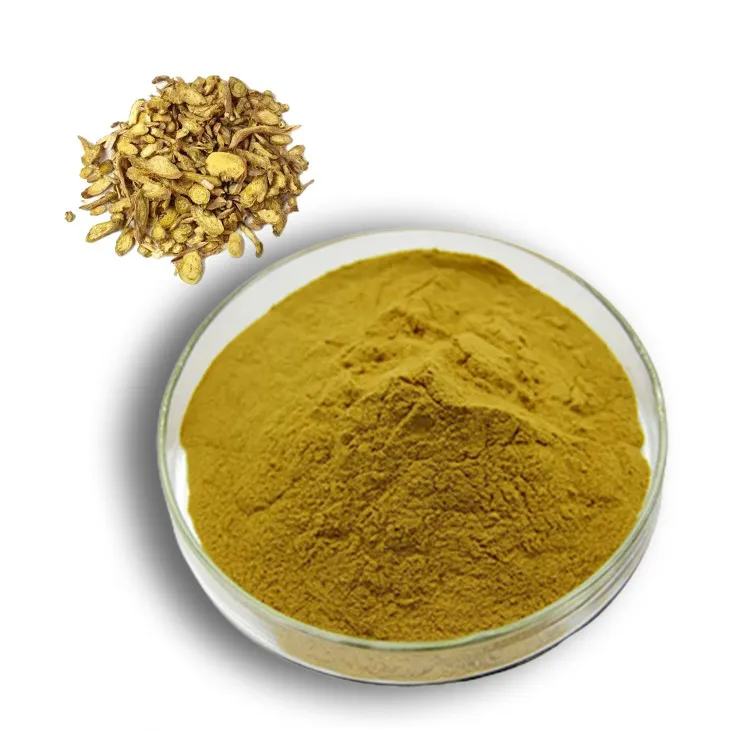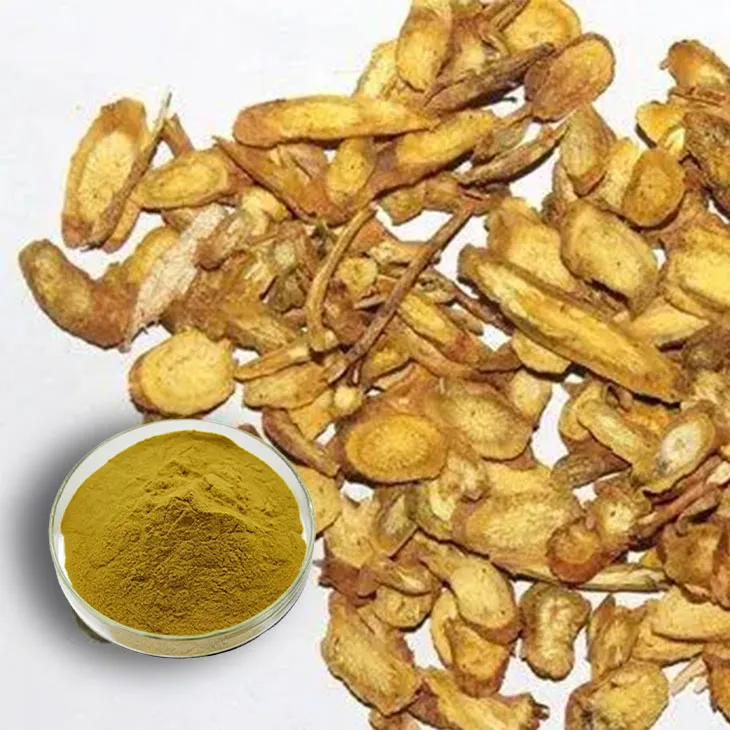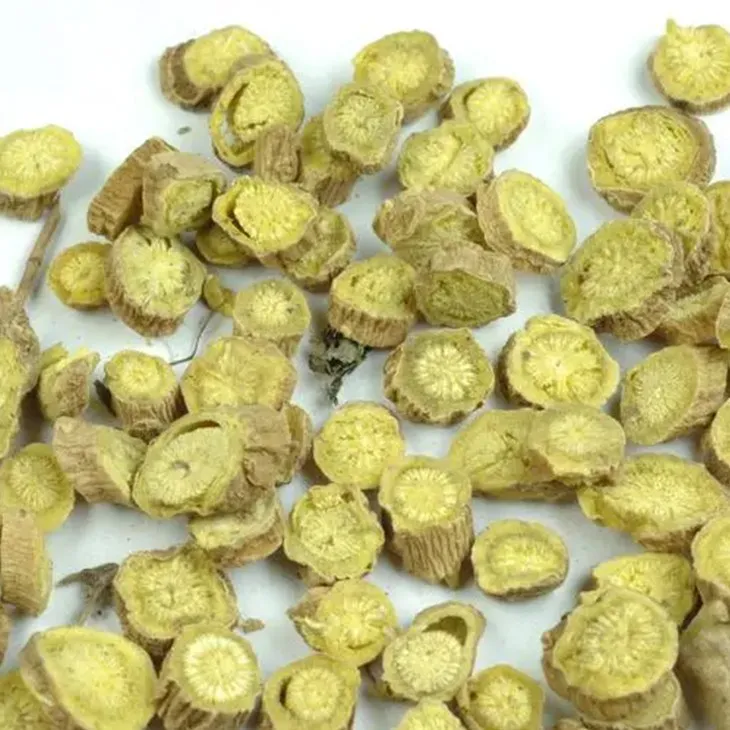- 0086-571-85302990
- sales@greenskybio.com
The Best Baicalin in 2024.
2024-11-28

Introduction to Baicalin
Baicalin has emerged as a compound of significant interest in the scientific and medical communities in 2024. It is a flavonoid glycoside that is mainly derived from the roots of Scutellaria baicalensis Georgi. Over the years, it has been the focus of extensive research due to its diverse range of potential applications.

Pharmacological Significance
Antibacterial Activities
One of the most remarkable properties of Baicalin is its antibacterial activities. Baicalin has the ability to interfere with the growth and reproduction of bacteria. In the current scenario where antibiotic - resistant bacteria are a major concern, baicalin offers new hope. It can act against not only common bacteria but also some drug - resistant bacteria.
The mechanism behind this antibacterial effect is complex. It may involve disrupting the bacterial cell wall synthesis, interfering with bacterial protein synthesis, or affecting the bacterial cell membrane integrity. This property of baicalin has spurred research into its potential as a new class of antibiotics or as an adjuvant to existing antibiotics.
Traditional Medicine Applications
In traditional medicine, baicalin has a long - standing history of use. It is renowned for its heat - clearing and detoxifying effects. For centuries, it has been used to treat various febrile diseases and conditions associated with toxicity in the body.
Modern research is now delving deeper into understanding the mechanisms underlying these traditional uses. Scientists are exploring how baicalin exerts its effects in treating febrile diseases. It may be related to its anti - inflammatory properties, as fever is often associated with an inflammatory response in the body. In the case of treating toxicosis, baicalin may help in detoxifying the body by enhancing the liver's detoxification function or by directly binding to and neutralizing toxins.

Factors Affecting the Quality of Baicalin
Source of Raw Materials
The source of raw materials is a crucial factor in determining the quality of baicalin. Baicalin obtained from high - quality Scutellaria baicalensis Georgi plants is more likely to possess better properties. The growth environment of these plants plays a significant role.
- Plants grown in suitable soil conditions, with proper nutrient availability, are likely to produce better - quality baicalin. For example, soil with a balanced pH and rich in essential minerals can enhance the growth and biosynthesis of baicalin in the plants.
- Climate also affects the quality of baicalin. Adequate sunlight, temperature, and rainfall are essential for the healthy growth of Scutellaria baicalensis Georgi plants. Regions with a temperate climate and distinct seasons may be more conducive to the production of high - quality baicalin.
Biotechnology and Cultivation Techniques
With the advancement of biotechnology, new methods are being explored to improve the quality of baicalin. Genetic engineering offers the potential to modify the genetic makeup of Scutellaria baicalensis Georgi plants to enhance baicalin production or improve its quality.
Advanced cultivation techniques also play a role. For instance, precision farming methods can ensure optimal growing conditions for the plants. Hydroponic cultivation may be explored as an alternative method to traditional soil - based cultivation, which could potentially lead to more consistent and higher - quality baicalin production.

Safety Profile of Baicalin
Although baicalin has numerous beneficial effects, a comprehensive safety evaluation is essential. This includes short - term and long - term toxicity studies.
- In the short - term, researchers need to determine the appropriate dosage range to avoid adverse effects such as allergic reactions or gastrointestinal disturbances. Clinical trials are often conducted to assess the safety and tolerability of baicalin at different doses.
- Long - term toxicity studies are crucial to ensure its safe use in various applications, especially for chronic conditions. These studies may involve monitoring the effects of baicalin on different organs over an extended period, such as the liver, kidneys, and heart. Potential long - term effects on the immune system and hormonal balance also need to be investigated.
Interactions with other drugs also need to be considered. Baicalin may interact with certain medications, either enhancing or reducing their efficacy. For example, it may interact with drugs metabolized by the liver cytochrome P450 system, potentially leading to altered drug levels in the body.

Conclusion
In conclusion, as we explore the best baicalin in 2024, we need to consider multiple factors. The pharmacological properties of baicalin, especially its antibacterial and traditional medicine - related effects, make it a compound with great potential. However, to ensure the availability of high - quality baicalin, attention must be paid to the source of raw materials, the application of biotechnology and cultivation techniques, and a comprehensive safety evaluation.
Future research should focus on further elucidating the mechanisms of action of baicalin, optimizing its production processes, and conducting more in - depth safety studies. Only through these efforts can we fully realize the potential of baicalin and make it a more widely applicable and safe compound in various fields, such as medicine, pharmaceuticals, and even the food industry.
FAQ:
What are the main pharmacological activities of baicalin?
Baicalin exhibits remarkable antibacterial activities. It can interfere with the growth and reproduction of bacteria, including some drug - resistant bacteria. It also has heat - clearing and detoxifying effects in traditional medicine, and modern research is exploring its mechanisms in treating febrile diseases and toxicosis.
Why is the source of raw materials important for the best baicalin?
The source of raw materials is a key factor for the best baicalin. Baicalin obtained from high - quality Scutellaria baicalensis Georgi plants grown in suitable environments is likely to have better properties.
How can biotechnology affect the quality of baicalin?
With the development of biotechnology, genetic engineering and cultivation techniques may affect the quality of baicalin. These techniques can potentially improve the production and quality of baicalin.
What safety evaluations are necessary for baicalin?
Although baicalin has many beneficial effects, comprehensive safety evaluations, including long - term toxicity studies, are necessary to ensure its safe use in different applications.
What are the potential applications of baicalin in the future?
Due to its antibacterial properties, baicalin may have potential applications in the development of new antibiotics. Also, its traditional uses in treating febrile diseases and toxicosis may be further explored and developed in modern medicine.
Related literature
- The Pharmacological Properties of Baicalin: A Comprehensive Review"
- "Baicalin from Scutellaria baicalensis Georgi: Quality and Its Influence Factors"
- "Safety Evaluation of Baicalin in Medical Applications"
- ▶ Hesperidin
- ▶ citrus bioflavonoids
- ▶ plant extract
- ▶ lycopene
- ▶ Diosmin
- ▶ Grape seed extract
- ▶ Sea buckthorn Juice Powder
- ▶ Beetroot powder
- ▶ Hops Extract
- ▶ Artichoke Extract
- ▶ Reishi mushroom extract
- ▶ Astaxanthin
- ▶ Green Tea Extract
- ▶ Curcumin Extract
- ▶ Horse Chestnut Extract
- ▶ Other Problems
- ▶ Boswellia Serrata Extract
- ▶ Resveratrol Extract
- ▶ Marigold Extract
- ▶ Grape Leaf Extract
- ▶ blog3
- ▶ blog4
-
Chinese Oyster Peptide Powder Factories.
2024-11-28
-
The best organic L - carnitine.
2024-11-28
-
Certified organic acerola cherry extract.
2024-11-28
-
Wholesale β - carotene suppliers.
2024-11-28
-
Chinese lemon balm extract factories.
2024-11-28
-
100% Pure Organic Bitter Melon Extract.
2024-11-28
-
100% Pure Natural Yellow Pine Extract.
2024-11-28
-
Soy Extract
2024-11-28
-
Peppermint Extract Powder
2024-11-28
-
Sophora Japonica Flower Extract
2024-11-28
-
Maca Extract
2024-11-28
-
Citrus Aurantii Extract
2024-11-28
-
Jujube Extract
2024-11-28
-
Bamboo Leaf extract
2024-11-28
-
Beetroot juice Powder
2024-11-28
-
Motherwort Extract
2024-11-28
-
Green Tea Extract
2024-11-28





















